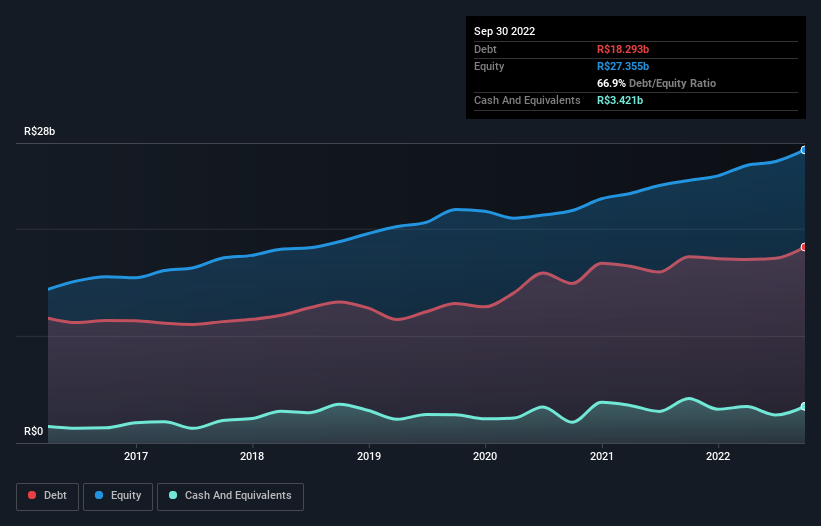- Brazil
- /
- Water Utilities
- /
- BOVESPA:SBSP3
We Think Companhia de Saneamento Básico do Estado de São Paulo - SABESP (BVMF:SBSP3) Is Taking Some Risk With Its Debt

The external fund manager backed by Berkshire Hathaway's Charlie Munger, Li Lu, makes no bones about it when he says 'The biggest investment risk is not the volatility of prices, but whether you will suffer a permanent loss of capital.' So it might be obvious that you need to consider debt, when you think about how risky any given stock is, because too much debt can sink a company. We note that Companhia de Saneamento Básico do Estado de São Paulo - SABESP (BVMF:SBSP3) does have debt on its balance sheet. But the more important question is: how much risk is that debt creating?
Why Does Debt Bring Risk?
Generally speaking, debt only becomes a real problem when a company can't easily pay it off, either by raising capital or with its own cash flow. Part and parcel of capitalism is the process of 'creative destruction' where failed businesses are mercilessly liquidated by their bankers. However, a more common (but still painful) scenario is that it has to raise new equity capital at a low price, thus permanently diluting shareholders. Of course, debt can be an important tool in businesses, particularly capital heavy businesses. When we examine debt levels, we first consider both cash and debt levels, together.
Check out our latest analysis for Companhia de Saneamento Básico do Estado de São Paulo - SABESP
What Is Companhia de Saneamento Básico do Estado de São Paulo - SABESP's Debt?
As you can see below, at the end of September 2022, Companhia de Saneamento Básico do Estado de São Paulo - SABESP had R$18.3b of debt, up from R$17.4b a year ago. Click the image for more detail. However, it also had R$3.42b in cash, and so its net debt is R$14.9b.

How Strong Is Companhia de Saneamento Básico do Estado de São Paulo - SABESP's Balance Sheet?
We can see from the most recent balance sheet that Companhia de Saneamento Básico do Estado de São Paulo - SABESP had liabilities of R$4.84b falling due within a year, and liabilities of R$23.8b due beyond that. On the other hand, it had cash of R$3.42b and R$3.34b worth of receivables due within a year. So its liabilities outweigh the sum of its cash and (near-term) receivables by R$21.9b.
This is a mountain of leverage relative to its market capitalization of R$36.3b. Should its lenders demand that it shore up the balance sheet, shareholders would likely face severe dilution.
We use two main ratios to inform us about debt levels relative to earnings. The first is net debt divided by earnings before interest, tax, depreciation, and amortization (EBITDA), while the second is how many times its earnings before interest and tax (EBIT) covers its interest expense (or its interest cover, for short). Thus we consider debt relative to earnings both with and without depreciation and amortization expenses.
With a debt to EBITDA ratio of 2.3, Companhia de Saneamento Básico do Estado de São Paulo - SABESP uses debt artfully but responsibly. And the alluring interest cover (EBIT of 9.8 times interest expense) certainly does not do anything to dispel this impression. Sadly, Companhia de Saneamento Básico do Estado de São Paulo - SABESP's EBIT actually dropped 3.2% in the last year. If that earnings trend continues then its debt load will grow heavy like the heart of a polar bear watching its sole cub. When analysing debt levels, the balance sheet is the obvious place to start. But ultimately the future profitability of the business will decide if Companhia de Saneamento Básico do Estado de São Paulo - SABESP can strengthen its balance sheet over time. So if you're focused on the future you can check out this free report showing analyst profit forecasts.
Finally, a company can only pay off debt with cold hard cash, not accounting profits. So we clearly need to look at whether that EBIT is leading to corresponding free cash flow. In the last three years, Companhia de Saneamento Básico do Estado de São Paulo - SABESP created free cash flow amounting to 14% of its EBIT, an uninspiring performance. That limp level of cash conversion undermines its ability to manage and pay down debt.
Our View
Neither Companhia de Saneamento Básico do Estado de São Paulo - SABESP's ability to convert EBIT to free cash flow nor its level of total liabilities gave us confidence in its ability to take on more debt. But its interest cover tells a very different story, and suggests some resilience. It's also worth noting that Companhia de Saneamento Básico do Estado de São Paulo - SABESP is in the Water Utilities industry, which is often considered to be quite defensive. When we consider all the factors discussed, it seems to us that Companhia de Saneamento Básico do Estado de São Paulo - SABESP is taking some risks with its use of debt. So while that leverage does boost returns on equity, we wouldn't really want to see it increase from here. There's no doubt that we learn most about debt from the balance sheet. However, not all investment risk resides within the balance sheet - far from it. We've identified 1 warning sign with Companhia de Saneamento Básico do Estado de São Paulo - SABESP , and understanding them should be part of your investment process.
At the end of the day, it's often better to focus on companies that are free from net debt. You can access our special list of such companies (all with a track record of profit growth). It's free.
New: AI Stock Screener & Alerts
Our new AI Stock Screener scans the market every day to uncover opportunities.
• Dividend Powerhouses (3%+ Yield)
• Undervalued Small Caps with Insider Buying
• High growth Tech and AI Companies
Or build your own from over 50 metrics.
Have feedback on this article? Concerned about the content? Get in touch with us directly. Alternatively, email editorial-team (at) simplywallst.com.
This article by Simply Wall St is general in nature. We provide commentary based on historical data and analyst forecasts only using an unbiased methodology and our articles are not intended to be financial advice. It does not constitute a recommendation to buy or sell any stock, and does not take account of your objectives, or your financial situation. We aim to bring you long-term focused analysis driven by fundamental data. Note that our analysis may not factor in the latest price-sensitive company announcements or qualitative material. Simply Wall St has no position in any stocks mentioned.
About BOVESPA:SBSP3
Companhia de Saneamento Básico do Estado de São Paulo - SABESP
Provides basic and environmental sanitation services in the São Paulo State, Brazil.
Outstanding track record and fair value.


